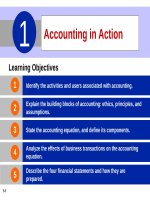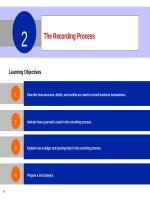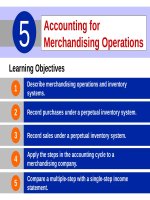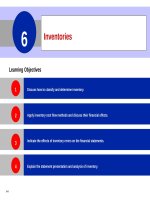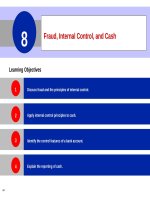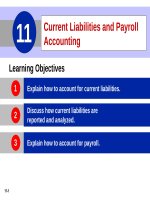Accounting principles 10e by kieso chapter 16
Bạn đang xem bản rút gọn của tài liệu. Xem và tải ngay bản đầy đủ của tài liệu tại đây (972.71 KB, 46 trang )
16-1
CHAPTER16
Investments
16-2
PreviewofCHAPTER16
16-3
Why Corporations Invest
Corporations generally invest in debt or stock securities
for one of three reasons.
1. Corporation may have excess cash.
2. To generate earnings from investment income.
3. For strategic reasons.
Illustration 16-1
Temporary
investments
and the
operating cycle
16-4
SO 1 Discuss why corporations invest in debt and stock securities.
Why Corporations Invest
Question
Pension funds and banks regularly invest in debt and stock
securities to:
16-5
a.
house excess cash until needed.
b.
generate earnings.
c.
meet strategic goals.
d.
avoid a takeover by disgruntled investors.
SO 1 Discuss why corporations invest in debt and stock securities.
Accounting for Debt Investments
Recording Acquisition of Bonds
Cost includes all expenditures necessary to acquire these
investments, such as the price paid plus brokerage fees
(commissions), if any.
Recording Bond Interest
Calculate and record interest revenue based upon the
carrying value of the bond times the interest rate times the
portion of the year the bond is outstanding.
16-6
SO 2 Explain the accounting for debt investments.
Accounting for Debt Investments
Recording Sale of Bonds
Credit the investment account for the cost of the bonds and
record as a gain or loss any difference between the net
proceeds from the sale (sales price less brokerage fees)
and the cost of the bonds.
16-7
SO 2 Explain the accounting for debt investments.
Accounting for Debt Investments
Illustration: Kuhl Corporation acquires 50 Doan Inc. 8%, 10year, $1,000 bonds on January 1, 2012, for $54,000, including
brokerage fees of $1,000. The entry to record the investment
is:
Jan. 1
Debt investments
Cash
16-8
54,000
54,000
SO 2 Explain the accounting for debt investments.
Accounting for Debt Investments
Illustration: Kuhl Corporation acquires 50 Doan Inc. 8%, 10year, $1,000 bonds on January 1, 2012, for $54,000, including
brokerage fees of $1,000. The bonds pay interest semiannually
on July 1 and January 1. The entry for the receipt of interest on
July 1 is:
July 1
Cash
2,000 *
Interest revenue
*
16-9
2,000
($50,000 x 8% x ½ = $2,000)
SO 2 Explain the accounting for debt investments.
Accounting for Debt Investments
Illustration: If Kuhl Corporation’s fiscal year ends on
December 31, prepare the entry to accrue interest since July 1.
Dec. 31
Interest receivable
2,000
Interest revenue
2,000
Kuhl reports receipt of the interest on January 1 as follows.
Jan. 1
Cash
2,000
Interest receivable
16-10
2,000
SO 2 Explain the accounting for debt investments.
Accounting for Debt Investments
Illustration: Assume that Kuhl corporation receives net
proceeds of $58,000 on the sale of the Doan Inc. bonds on
January 1, 2013, after receiving the interest due. Prepare the
entry to record the sale of the bonds.
Jan. 1
Cash
58,000
Debt investments
Gain on sale of investments
16-11
54,000
4,000
SO 2 Explain the accounting for debt investments.
Accounting for Debt Investments
Question
An event related to an investment in debt securities that
does not require a journal entry is:
16-12
a.
acquisition of the debt investment.
b.
receipt of interest revenue from the debt investment.
c.
a change in the name of the firm issuing the debt
securities.
d.
sale of the debt investment.
SO 2 Explain the accounting for debt investments.
Accounting for Debt Investments
Question
When bonds are sold, the gain or loss on sale is the
difference between the:
16-13
a.
sales price and the cost of the bonds.
b.
net proceeds and the cost of the bonds.
c.
sales price and the market value of the bonds.
d.
net proceeds and the market value of the bonds.
SO 2 Explain the accounting for debt investments.
Accounting for Stock Investments
Ownership Percentages
0 ------------------20% -------------- 50% -------------------- 100%
No significant
influence
usually exists
Significant
influence
usually exists
Investment
valued using
Cost
Method
Investment
valued using
Equity
Method
Control usually
exists
Investment valued on
parent’s books using Cost
Method or Equity Method
(investment eliminated in
Consolidation)
The accounting depends on the extent of the investor’s influence over
the operating and financial affairs of the issuing corporation.
16-14
SO 3 Explain the accounting for stock investments.
Accounting for Stock Investments
Holding of Less than 20%
Companies use the cost method. Under the cost method,
companies record the investment at cost, and recognize
revenue only when cash dividends are received.
Cost includes all expenditures necessary to acquire these
investments, such as the price paid plus any brokerage fees
(commissions).
16-15
SO 3 Explain the accounting for stock investments.
Holding of Less than 20%
Recording Acquisition of Stock Investments
Illustration: On July 1, 2012, Sanchez Corporation acquires
1,000 shares (10% ownership) of Beal Corporation common
stock. Sanchez pays $40 per share plus brokerage fees of $500.
The entry for the purchase is:
July 1
Stock investments
Cash
16-16
40,500
40,500
SO 3 Explain the accounting for stock investments.
Holding of Less than 20%
Recording Dividends
Illustration: During the time Sanchez owns the stock, it makes
entries for any cash dividends received. If Sanchez receives a
$2 per share dividend on December 31, the entry is:
Dec. 31
Cash
2,000
Dividend revenue
16-17
2,000
SO 3 Explain the accounting for stock investments.
Holding of Less than 20%
Recording Sale of Stock
Illustration: Assume that Sanchez Corporation receives net
proceeds of $39,500 on the sale of its Beal stock on February
10, 2013. Because the stock cost $40,500, Sanchez incurred
a loss of $1,000. The entry to record the sale is:
Feb. 10
Cash
39,500
Loss on sale of stock
Stock investments
16-18
1,000
40,500
SO 3 Explain the accounting for stock investments.
Accounting for Stock Investments
Holding Between 20% and 50%
Equity Method: Record the investment at cost and
subsequently adjust the amount each period for the
investor’s proportionate share of the earnings (losses)
and
dividends received by the investor.
If investor’s share of investee’s losses exceeds the carrying amount of the
investment, the investor ordinarily should discontinue applying the equity
method.
16-19
SO 3 Explain the accounting for stock investments.
Holdings Between 20% and 50%
Question
Under the equity method, the investor records dividends
received by crediting:
16-20
a.
Dividend Revenue.
b.
Investment Income.
c.
Revenue from Investment.
d.
Stock Investments.
SO 3 Explain the accounting for stock investments.
Holdings Between 20% and 50%
Illustration: Milar Corporation acquires 30% of the common
shares of Beck Company for $120,000 on January 1, 2012. For
2012, Beck reports net income of $100,000 and paid dividends of
$40,000. Prepare the entries for these transactions.
Jan. 1
Stock investments
120,000
Cash
120,000
Dec. 31 Stock investments ($100,000 x 30%)
30,000
Revenue from investments
Dec. 31 Cash($40,000 x 30%)
12,000
Stock investments
16-21
30,000
12,000
SO 3 Explain the accounting for stock investments.
Holdings Between 20% and 50%
Illustration: Milar Corporation acquires 30% of the common
shares of Beck Company for $120,000 on January 1, 2012. For
2012, Beck reports net income of $100,000 and paid dividends of
$40,000. Prepare the entries for these transactions.
After Milar posts the transactions for the year, its investment
and revenue accounts will show the following.
Illustration 16-4
16-22
SO 3 Explain the accounting for stock investments.
Accounting for Stock Investments
Holdings of More than 50%
Controlling Interest - When one corporation acquires a voting
interest of more than 50 percent in another corporation
16-23
Investor is referred to as the parent.
Investee is referred to as the subsidiary.
Investment in the subsidiary is reported on the parent’s
books as a long-term investment.
Parent generally prepares consolidated financial
statements.
SO 4 Describe the use of consolidated financial statements.
16-24
Valuing and Reporting Investments
Categories of Securities
Companies classify debt and stock investments into three
categories:
Trading securities
Available-for-sale securities
Held-to-maturity securities
These guidelines apply to all debt securities and all stock investments in
which the holdings are less than 20%.
16-25
SO 5 Indicate how debt and stock investments are reported in financial statements.

